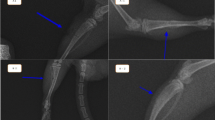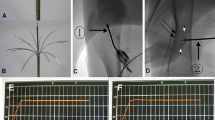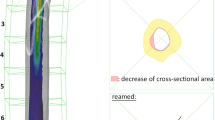Abstract
Study question
Pathologic bone fractures in cryosurgery of bone tumors have been described in literature. This study utilizing a sheep model should prove the possible reduction of potential fracture while using a new miniature cryoprobe minimizing tissue damage and providing accurate control of the ablation process. Furthermore, postoperative histological changes should be investigated and the results correlated with the stability trials.
Methods
In 24 sheep, ablation of the femur and the tibial bone on one side was carried out. Ablation of the right femur was limited to an area of 2 cm2 with single cortical bone, whereas at the left tibia the whole proximal tibial plateau was included. The other side served as a control entity without cryoablation. After a period of 2, 4, and 6 months postoperative investigation of bending resistance of the femoral bone and of compression resistance of the tibial bone as well as histological findings were done in eight animals each.
Results
After 2 months there was a significant difference (P < 0.05) regarding compression resistance between the treated and the contralateral tibia, whereas the bending resistance in the treated femur was slightly lower than on the contralateral side. After 4 and 6 months the cryo-treated part showed a tendency towards weakness. Histological findings showed bone necrosis with slight beginning repair after 2 months. Four and six months later, bone necrosis still existed with increasing development of woven bone and conversion into lamellar bone.
Discussion
A thorough control of the freezing process and the low iatrogenous weakening of the bone due to placing the probe when modern miniature cryoprobes are used can minimize the risk of pathological postoperative fractures. However, at least 2 months after operation there is histological proof of bone healing with appropriate reduction of bone stability, which should be considered for the clinical application of this new technique.




Similar content being viewed by others
References
Fisher AD, Williams DF, Bradley PF (1978) The effect of cryosurgery on the strength of bone. Br J Oral Surg 15(3):215–222
Gage AA, Greene GW Jr, Neiders ME, Emmings FG (1966) Freezing bone without excision. An experimental study of bone-cell destruction and manner of regrowth in dogs. Jama 196(9):770–774
Hewitt PM, Zhao J, Akhter J, Morris DL (1997) A comparative laboratory study of liquid nitrogen and argon gas cryosurgery systems. Cryobiology 35(4):303–308
Keijser LC, Schreuder HW, Doerwald N, Keulers BJ, Buma P, Huiskes R, Veth RP (2000) Bone strength after cryosurgical treatment of long bones: an experimental study in the goat. 10th Conference of the European Orthopaedic Research Society, Wiesbaden
Kerschbaumer F, Russe W, Bauer R (1984) Principles of cryosurgery in orthopedics. Orthopade 13(2):133–141
Malawer MM, Bickels J, Meller I, Buch RG, Henshaw RM, Kollender Y (1999) Cryosurgery in the treatment of giant cell tumor A long-term followup study. Clin Orthop Relat Res 359:176–188
Marcove RC, Miller TR (1969) Treatment of primary and metastatic bone tumors by cryosurgery. Jama 207(10):1890–1894
Marcove RC, Sheth DS, Brien EW, Huvos AG, Healey JH (1994) Conservative surgery for giant cell tumors of the sacrum. The role of cryosurgery as a supplement to curettage and partial excision. Cancer 74(4):1253–1260
Marcove RC, Weis LD, Vaghaiwalla MR, Pearson R (1978) Cryosurgery in the treatment of giant cell tumors of bone: a report of 52 consecutive cases. Clin Orthop Relat Res (134):275–289
Marcove RC, Weis LD, Vaghaiwalla MR, Pearson R, Huvos AG (1978) Cryosurgery in the treatment of giant cell tumors of bone. A report of 52 consecutive cases. Cancer 41(3):957–969
Popken F, Bertram C, Konig P, Rutt J, Land M, Hackenbroch MH (2002) The cryosurgical ablation of bone tissue by means of a new miniature cryoprobe—evaluation of the probe and adaption of the method to in vitro human bone. Arch Orthop Trauma Surg 122(3):129–133
Popken F, Bertram C, Land M, Konig DP, Bilgic M, Jeschkeit S, Hackenbroch MH, Fischer JH (2001) Cryosurgical ablation of bone tissue with a newly developed miniature cryoprobe—adaptation of the method for use in bones in vitro and in vivo. Z Orthop Ihre Grenzgeb 139(1):64–69
Popken F, Land M, Bosse M, Erberich H, Meschede P, Konig DP, Fischer JH, Eysel P (2003) Cryosurgery in long bones with new miniature cryoprobe: an experimental in vivo study of the cryosurgical temperature field in sheep. Eur J Surg Oncol 29(6):542–547
Schreuder HW, Conrad EU 3rd, Bruckner JD, Howlett AT, Sorensen LS (1997) Treatment of simple bone cysts in children with curettage and cryosurgery. J Pediatr Orthop 17(6):814–820
Schreuder HW, Pruszczynski M, Veth RP, Lemmens JA (1998) Treatment of benign and low-grade malignant intramedullary chondroid tumours with curettage and cryosurgery. Eur J Surg Oncol 24(2):120–126
Acknowledgment
This study was supported by the Köln Fortune Program of the University of Cologne.
Author information
Authors and Affiliations
Corresponding author
Rights and permissions
About this article
Cite this article
Popken, F., Michael, J.WP., Zarghooni, K. et al. Stability changes after cryosurgery in long tubular bones in correlation to histological results: an animal trial. Arch Orthop Trauma Surg 129, 857–862 (2009). https://doi.org/10.1007/s00402-008-0704-9
Received:
Published:
Issue Date:
DOI: https://doi.org/10.1007/s00402-008-0704-9




